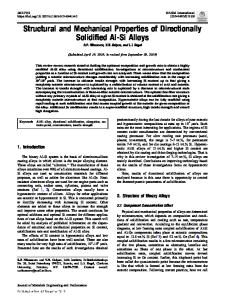Influence of Al-B grain refiner on porosity formation of directionally solidified Al-Si alloys
- PDF / 1,337,584 Bytes
- 6 Pages / 612.283 x 858.898 pts Page_size
- 84 Downloads / 351 Views
https://doi.org/10.1007/s41230-020-0012-8
Influence of Al-B grain refiner on porosity formation of directionally solidified Al-Si alloys *Muhammet Uludağ Bursa Technical University, Metallurgical and Materials Engineering Department, Bursa, Turkey
Abstract: This work aims to present a perspective for porosity formation in three different alloys: A356, A413 and A380.1 by taking into account the addition of Al-B grain refiners: AlTi5B1 and Al3B. The directional solidification method was used, and microstructural changes of the alloys and its correlation with porosity formation were investigated. Pore size, number of pores, average pore length and distribution of pores were statistically analyzed. Also, external shrinkage was examined, and the volume of external shrinkage was calculated. It was found that there was a relationship between external shrinkage and the size and number of pores. As the size and number of pores internally decrease, external shrinkage increases. Additionally, porosity is decreased in all the three Al-Si alloys when Al-B grain refiners are used. The distribution of pore diameters is low when AlTi5B1 is used. Grain refiners have a different effect on porosity formation of Al-Si alloys with regard to their solidification morphology. Key words: Al-Si alloys; directional solidification; grain refinement; internal porosity; external shrinkage CLC numbers: TG146.21
Document code: A
A
luminum alloys are preferred by the automotive industry due to their properties such as good castability, high strength and corrosion resistance [1]. These properties are mainly influenced by microstructure [2, 3]. Changes in microstructure can also affect porosity formation [4-7]. It is well known that the addition of Al-Ti-B master alloy into an Al-Si alloy will alter the microstructure from coarse α-Al to finer equiaxed dendritic morphology without changing the eutectic silicon morphology [8]. When it comes to the selection of master alloy, Al3Ti3B and Al5Ti1B grain refiners were compared in terms of effect on both microstructure and porosity formation [9]. It was concluded that Al3Ti3B grain refiner has a greater effect to prevent the porosity than Al5Ti1B grain refiner. As an alternative Al-Ti grain refiner of Al alloys, Al3B master alloy that contains no Ti was also studied. This master alloy contains B, AlB2 and AlB12 particles. AlB12 can be unstable depending on the B content of the melt and reacts with Al to form AlB2 which is a peritectic reaction [10, 11]. In casting applications, it has *Muhammet Uludağ Male, born in 1982, Ph.D, Assistant Professor, Researcher. His research interests mainly focus on aluminum alloys, high pressure die casting process, improvement of casting quality and mechanical properties, microstructural characterization, heat treatment of aluminum alloys, and casting simulation. To date, he has published 25 technical papers in journals and more than 80 proceedings papers. E-mail: [email protected]
Received: 2020-02-01; Accepted: 2020-06-23 372
Article ID: 1672-6421(2020)05-372-0
Data Loading...











